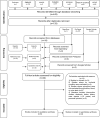Opiorphin as a biomarker of orofacial conditions: a meta-analysis
- PMID: 37726305
- PMCID: PMC10509258
- DOI: 10.1038/s41598-023-42051-y
Opiorphin as a biomarker of orofacial conditions: a meta-analysis
Abstract
The aim of this meta-analysis was to answer the following question: "Are there any differences in opiorphin biomarker concentrations between different orofacial conditions and controls?". Two reviewers searched for observational studies that evaluated the levels of opiorphin in orofacial conditions, annotated in seven main databases and three that compile gray literature. Of the 443 articles obtained initially, 8 met the inclusion criteria for quantitative analyses. Relative percentages showed a mean 24.1% higher opiorphin concentration in chronic conditions (Burning Mouth Syndrome, Oral Potentially Malignant Diseases and Temporomandibular Disorder) compared to controls; 33.2% higher opiorphin in sustained pain (Symptomatic Irreversible Pulpitis, Symptomatic Apical Periodontitis, Painful Oral Soft-tissue conditions); and 21.7% higher opiorphin after stimuli (Corneal Foreign Body, Capsaicin). Meta-analysis revealed a standardized mean difference of 0.62 [0.02, 1.22] in the absolute concentration of opiorphin in saliva for the chronic group compared to the control. The analogous values for the sustained group and the stimulated group were 2.24 [0.34, 4.14] and 0.43 [0.00, 0.85], respectively. No differences in opiorphin levels were found for 'after Local Anesthesia before Tooth Extraction' or for apicoectomy. Based on the available evidence, in general, a statistically higher level of opiorphin is found in orofacial conditions. Salivary opiorphin levels are elevated in chronic, persisted and acute pain conditions, presumably reflecting a physiological homeostatic adaptative response to different conditions such as stress or pain. Salivary opiorphin might therefore be used as a valuable biomarker in several oral disorders.
© 2023. Springer Nature Limited.
Conflict of interest statement
The authors declare no competing interests.
Figures



References
-
- Williams ACC, Craig KD. Updating the definition of pain. Pain. 2016;157(11):2420–2423. - PubMed
-
- Porporatti, A., et al., Prevalence of Orofacial Pain Conditions: An Umbrella Review of Systematic Reviews. PROSPERO 2022 CRD42022377910. https://www.crd.york.ac.uk/prospero/display_record.php?ID=CRD42022377910.
-
- International Classification of Orofacial Pain, 1st edition (ICOP). Cephalalgia, 2020. 40(2): 129–221. - PubMed
-
- World Health Organization . Global Oral Health Status Report: Towards Universal Health Coverage for Oral Health by 2030. World Health Organization; 2022.
-
- Peres MA, et al. Oral diseases: A global public health challenge. Lancet. 2019;394(10194):249–260. - PubMed
Publication types
MeSH terms
Substances
LinkOut - more resources
Full Text Sources
Miscellaneous

